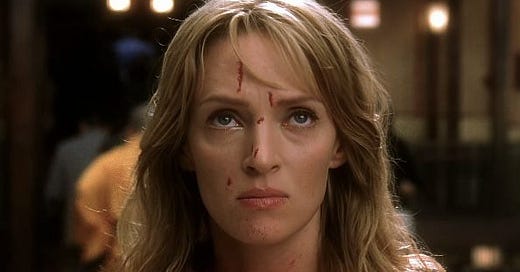Ideas discussed in this post are further developed in The Pretty Problem.
The rise of the so-called ‘female rage’ film genre has become a cultish fascination of primarily young women. Despite its title, by no means does it exclusively represent films about anger. The themes of these movies may explore desire, grief, and even coming-of-age in some cases. What brings these movies together is their emphasis on catharsis, whether for the protagonist or for the audience, although overwhelmingly the former do not tend to reap satisfaction from their generally violent actions. This genre is one that hinges more prominently on its audience’s reaction than on the story it has to tell. As long as it’s visceral, painful, and female, it can be added to a neatly curated list beside Kill Bill (2003).
One trend within the genre is a plot revolving around the revenge of the female protagonist. What interests me about this is that there is no common symbolic victim across shared by these films. Movies such as Thelma and Louise (1991) and Ginger Snaps (2000) can be placed firmly within the feminist camp, dealing with sexuality and sexual violence from a radical female perspective. Even the premises of these movies sound like textbook female rage movies. However, a film like Carrie (1975), while not intentionally operating within the realm of feminist filmmaking, is also considered to be a ‘female rage’ movie. Thematically, the only commonality it shares with other films in this genre is its vengeance-based plot, which does not explicitly or specifically attack patriarchy in the same way the aforementioned films do. There is no universal theme or message to be understood through the consumption of this genre as a whole.
It seems to be a misconception that the category overall pertains to feminist film, or to movies actively commenting on the patriarchy. Instead, it is accepted that this is a genre dependent most deeply on aesthetics. Of course, it is inclusive of many overtly feminist movies, such as Promising Young Woman (2020), but other films, such as Midsommar (2019) don’t seem to fit the bill thematically – and yet they are worshipped under the label of ‘female rage’.
Aesthetics are where real commonalities begin to emerge. Comparing Carrie with Ginger Snaps makes more sense when blood, gore, and violence are at stake. Importantly, to make a female rage movie, these must be heavily juxtaposed against femininity, which is explored in the most traditional hyper-heterosexual sense. What we as viewers of the trope rarely question is the concept of the feminine. Female aesthetics are utilised throughout these films, juxtaposing the beautiful with the violent. Often this functions as a sometimes-satirical comment on the pain of women caused by patriarchy, and often this is successful. Euphoria’s (2022) striking visual of Sydney Sweeney sobbing into a mirror surrounded by flower garlands, signifying femininity and vanity, conveys a similar message. But after a thousand scenes exploring the grief of femininity in this way, the commentary starts to feel empty, and the homogeneity sets in. I start to wonder whether we are truthfully continuing to explore womanhood in a meaningful and daring way, or if we are simply being sold the same old narrative by filmmakers who were supposed to save us.
In scenes like this, filmmakers continue to deliberately stylize shots in a way that perpetuates female objectification – perhaps with semi-appropriative intentions, but always with devastating effect. The Menkes List describes ways in which shot composition throughout the film canon has created an impenetrable trend of women’s objectification, including a point of view privileging a man as the subject, fragmentation of the female body, and two-dimensional lighting used to amplify actresses’ beauty. I understand the temptation to attempt to use these tools to subvert and uplift female narratives. It’s hard to satirise patriarchy when its own machinations are so ridiculous and clownish – the jokes practically tell themselves. And in many ways, the wounds of womanhood may seem to be best expressed by the oppressive predicates surrounding it. But in a canon where these types of shots have invariably been used to demean women, the reaction these techniques inspire from audiences will always be coded by oppressive gender roles.
Accepting aesthetics as the prominent appeal of the genre disregards the unique themes and conclusions explored by each of these films. In labelling a ‘female rage’ movie, we reduce the female protagonist’s experience to her femaleness without first acknowledging her humanity. Although it is important to address gender-based differences psychoanalytically, perhaps as this genre attempts to do, the category itself is reductionist, placing the spectrum of the female experience into a singular box, in which all women are supposed to find relatability and catharsis. Gone Girl (2014) should not be lowered to a ‘crazy woman movie’ when it looks at identity and the formation of reality alongside misogyny, rather than an attempt to display a definitive representation of womanhood under patriarchy. These films contain realms of cultural analysis even further than what the ‘female rage’ genre allows.
The way we as audiences approach ‘female rage’ movies is preventing us from constructively or representatively addressing misogyny via film. We fail to use the media we consume to move feminism forwards within our own lives, and instead revel in the fantasy of an equally gruesome rebuttal to male violence. Rather than imagining a world where women are allowed to take a destructive role, we should be asking why men have taken this role for so long. We cannot end brutal misogyny with our own brutality; Audre Lorde tells us we cannot dismantle the master’s house using the master’s tools. It is not revolutionary to permit the violence of women. It is only productive to be outraged by the violence of men.




this was so sexy of u to say